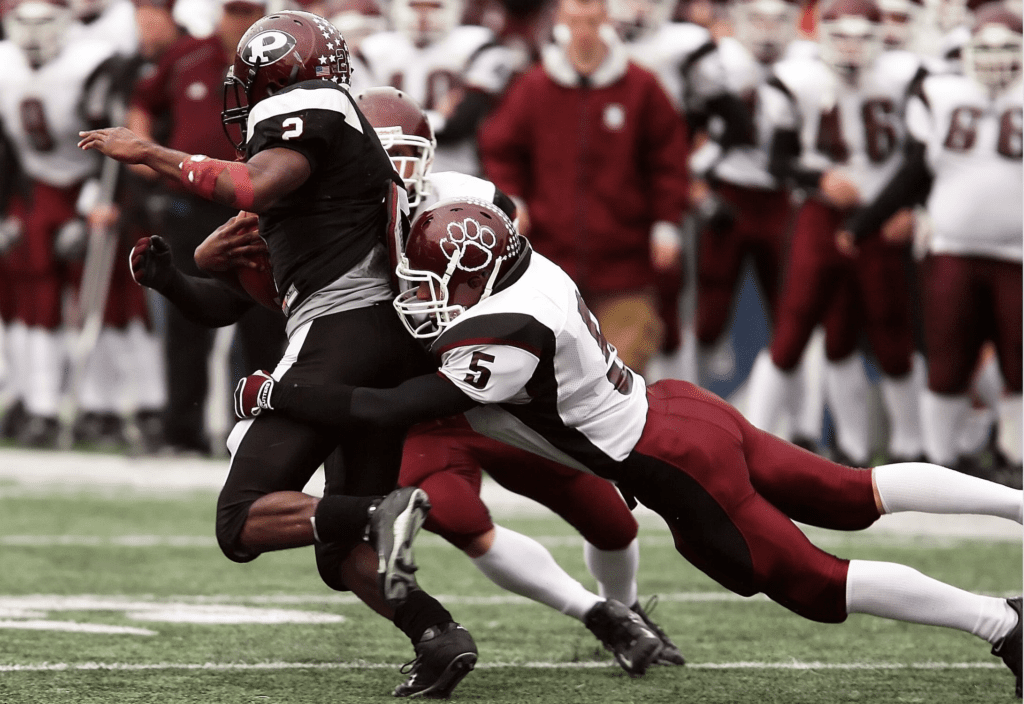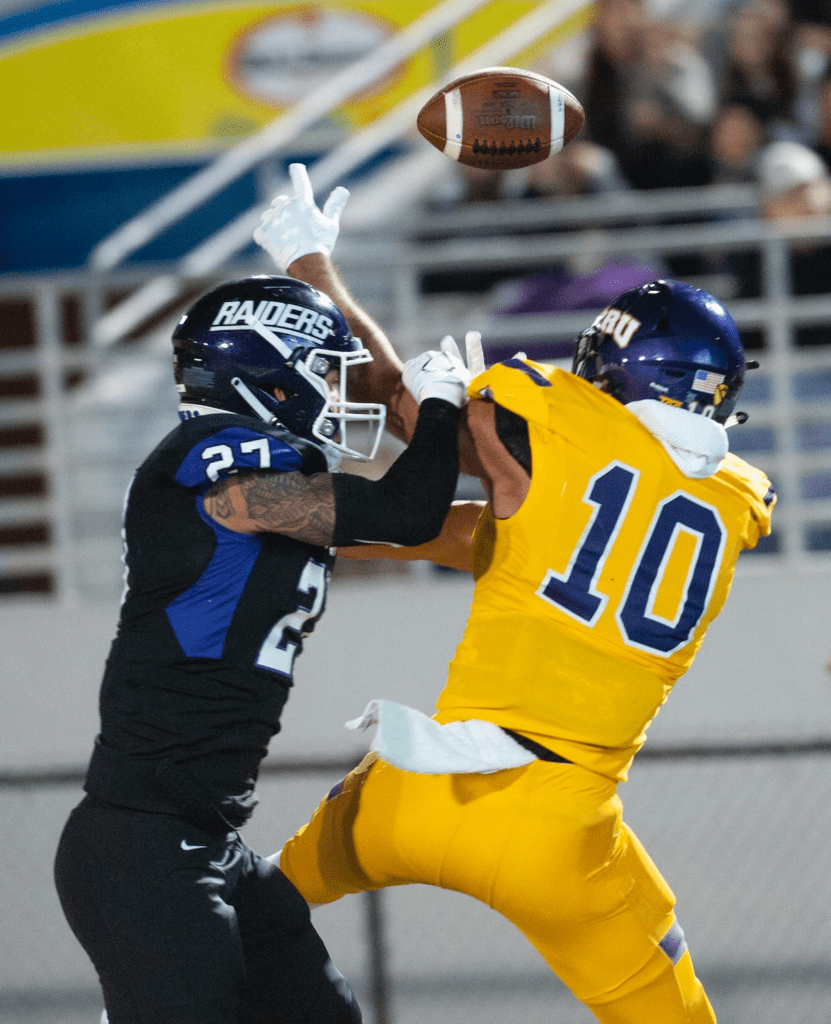A safety in American football is one of the most important and versatile positions on the football field. However, their roles and responsibilities can get mixed up with other defensive backs.
What does a safety do in football? The safety position is responsible for covering the deepest part of the field. They are the defense’s last line of defense and must make touchdown saving tackles if the offense completes a long pass.
This article will show you what a safety does in football and how many safeties a team usually has.
What Does A Safety Do In Football?
In the spread offense era, the safety position is arguably one of the most important positions in football.
The safety’s role on defense is ensuring no big plays happen. This means any play that happens of 20 yards or more is typically on the free safety and the strong safety.
The physical build of a safety is often bigger than that of a cornerback but smaller than a linebacker. The safety position must utilize both tremendous speeds as well as athletism.
NFL safeties such as Ed Reed and Troy Polamumnu are great examples of players covering the pass and run-down running backs that happen to gain big yards.
Run Play Responsibilities
On running plays, the safety in football is ten to fifteen yards from the line of scrimmage. They are not typically involved in the run fit.
Their primary job on run plays is to make sure that a running play doesn’t break loose for a touchdown. As their name states, they need to be the safety valve for the offense.
While they are deep defenders, they still need to be aggressive to the football. Each defensive scheme is different in how they use their safeties in the run fit.
For instance, in match quarters, the safeties will run downhill and help support any ball that is spilled to the outside. Both the free safety and strong safety are responsible for helping on the run play.
Pass Play Responsibilities
The safety is responsible for long pass plays. It’s the safety’s job to tackle any player who does catch the ball deep. As a primary pass defender, it’s both the free safety and the strong safety’s duties to try to intercept or knock down any pass that’s thrown in the air.
Long before football was a finesse game, teams could pack as many big, strong players onto the field as possible. These players could manhandle the offense to their advantage.
The invention of the forward pass changed all of that. Teams no longer tried to win with pure power but rather speed. Offenses spread out and used throwing the football down the field as the primary offensive strategy.
As football teams started to throw the ball downfield, defenses needed to match this aerial attack by adding speed to the field. This is how the safety position in modern-day football was born.
These safety positions are split into two types of safeties used most commonly.
Increase Your Football IQ
Why spend hours on Google and YouTube trying to learn football yourself? We’ve created a simple guide to help make you the smartest person in the room.
Safety Positions In Football
In most defensive schemes, there are two types of safeties. There is a free safety and strong safety in football. Depending on the types of plays the offense runs, if they have a tight end, and the types of passing plays they use, coaches may choose to use these two types of safeties.
Free Safety
The free safety position is common in most defensive structures. This player has a unique skill set as they must cover the ground. Players who play free safety are often the lone safety.
When watching a football game, this player will often be the deepest player on the field. The name free safety comes from the fact that the safety is often free to cover the deep part of the field.
For example, in the cover 1 scheme, the free safety supports any deep passes. They don’t necessarily have an assignment but rather help cover the middle of the field.
Many football coaches will put their most athletic and best tackler at the safety position. If a big play happens, this player needs to tackle the ball carrier immediately. They also need to be able to locate the eligible pass receivers and if the opposing team is trying any trickery.
Open field tackling is one of the hardest techniques to do in football. The free safety will practice and specialize in tackling players in the open field.
Strong Safety
The strong safety is a little bit different from the free safety.
Strong safeties are often built like linebackers; however, they have the speed of a safety. These players play the run and the pass, mainly the run.
They get their name strong safety because they must be strong and play the run from depth. The strong safety will often play at the same depth as a free safety but is responsible for playing a gap or run fit.
In the present-day NFL, the player that provides the best visual for strong safety is Tyrann Mathieu. Not only built tough in stature, but Tyrann also covers any pass that comes his way. His speed and physicality also allow him to play the run effectively, as he’s not scared of larger running backs.
Strong safeties are hybrids between linebackers and cornerbacks. The combination of size, speed, and ability to tackle are all wanted traits of strong safety.
Variations Of The Safety Position
Football differs from scheme to scheme. Not all football defenses will have players that are named free and strong safety.
The innovation of the spread offense has led teams to bring on more safeties to combat the 5 wide receiver sets that are commonly used.
Coaches will often use different name types to identify their safety positions, such as Rover, Jack, and Dollar.
This depends on the coach’s scheme and how he wants to use each player. Instead of just saying free and strong safety, naming these positions gives the coach flexibility to spin coverages and blitz if needed.
Free Safety Vs. Strong Safety
The difference between free safety and strong safety is typically in the player’s build, speed, and responsibility.
The free safety is often a smaller and quicker player. Strong safeties are often taller and stronger players who are fast and can tackle.
Strong safeties will have more responsibility to tackle running backs and cover receivers, while the safety is more responsible for covering deep passes thrown by the quarterback.
Keep Learning
The safety position is used by primarily every team in professional football. It’s the safeties’s duty to make sure every defensive back is on the same page on both running plays and passing plays.
Typically if a long touchdown is scored (any scoring play), it’s the fault of the safeties. The free safety should be the most athletic and loudest player on the team.
If you like learning about the free safety positions ( as well as the strong safety), we recommend you check out our Beginners Guide To Football below. It has everything you need to increase your football IQ.
Below are more articles to help you learn about defensive backs.
What Is A DB In American Football? Explained
Safety’s in football is one of the most important positions in football to ensure that big, explosive plays from the offense do not happen.
The skillset requires safeties to cover slot receivers and have enough speed to catch running backs across the field. The size and strength of safety make them look like linebackers, but their athleticism and speed will often be mistaken for a cornerback.
It’s a true hybrid position that can be used in multiple forms in defensive schemes.
Let’s keep learning! Our learning center is packed with techniques, schemes, and more!
If you’re looking for more in-depth breakdowns & coaching resources, visit our coaching resource page.





